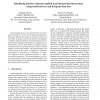BIBM
2008
IEEE
13 years 11 months ago
2008
IEEE
Protein fold recognition is the prediction of protein’s tertiary structure (Fold) given the protein’s sequence without relying on sequence similarity. Using machine learning t...
BIBM
2008
IEEE
13 years 11 months ago
2008
IEEE
We adapt a network simulation algorithm called quantitative simulation (QSim) for use in the alignment of biological networks. Unlike most network alignment methods, QSim finds l...
BIBM
2008
IEEE
13 years 11 months ago
2008
IEEE
Identifying functionally important sites from biological sequences, formulated as a biological sequence labeling problem, has broad applications ranging from rational drug design ...
BIBM
2008
IEEE
13 years 11 months ago
2008
IEEE
The study of gene function is critical in various genomic and proteomic fields. Due to the availability of tremendous amounts of different types of protein data, integrating thes...
BIBM
2008
IEEE
13 years 11 months ago
2008
IEEE
Genetical genomics has been established to study genetic variation of gene expression. It treats transcript expression as a quantitative trait and identifies putative regulatory l...
BIBM
2008
IEEE
13 years 11 months ago
2008
IEEE
We present new and novel insights into the behavior of two maximum parsimony heuristics for building evolutionary trees of different sizes. First, our results show that the heuris...
BIBM
2008
IEEE
13 years 11 months ago
2008
IEEE
Understanding what are the characteristics of proteinprotein interfaces is at the core of numerous applications. This paper introduces a method in which the proteins are described...
BIBM
2008
IEEE
13 years 11 months ago
2008
IEEE
Abstract—Compressive Sensing Microarrays (CSM) are DNAbased sensors that operate using group testing and compressive sensing (CS) principles. In contrast to conventional DNA micr...
BIBM
2008
IEEE
13 years 11 months ago
2008
IEEE
Network alignments are extensively used for comparing, exploring, and predicting biological networks. Existing alignment tools are mostly based on isomorphic and homeomorphic embe...
BIBM
2008
IEEE
13 years 11 months ago
2008
IEEE
Biologists are often interested to query published phylogenetic data for research purposes. PhyQL, a web-based visual phylogenetic query engine, can be quite useful on this regard...

